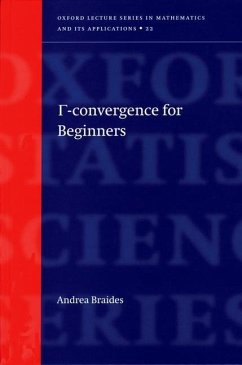This is a handbook of Gamma-convergence, which is a theoretical tool used to study problems in Applied Mathematics where varying parameters are present, with many applications that range from Mechanics to Computer Vision. The book is directed to Applied Mathematicians in all fields and to Engineers with a theoretical background.
The theory of Gamma-convergence is commonly recognized as an ideal and flexible tool for the description of the asymptotic behaviour of variational problems. Its applications range from the mathematical analysis of composites to the theory of phase transitions, from Image Processing to Fracture Mechanics. This text, written by an expert in the field, provides a brief and simple introduction to this subject, based on the treatment of a series of fundamental problems
that illustrate the main features and techniques of Gamma-convergence and at the same time provide a stimulating starting point for further studies. The main part is set in a one-dimensional framework that highlights the main issues of Gamma-convergence without the burden of higher-dimensional
technicalities. The text deals in sequence with increasingly complex problems, first treating integral functionals, then homogenisation, segmentation problems, phase transitions, free-discontinuity problems and their discrete and continuous approximation, making stimulating connections among those problems and with applications. The final part is devoted to an introduction to higher-dimensional problems, where more technical tools are usually needed, but the main techniques of Gamma-convergence
illustrated in the previous section may be applied unchanged.
The book and its structure originate from the author's experience in teaching courses on this subject to students at PhD level in all fields of Applied Analysis, and from the interaction with many specialists in Mechanics and Computer Vision, which have helped in making the text addressed also to a non-mathematical audience. The material of the book is almost self-contained, requiring only some basic notion of Measure Theory and Functional Analysis.
The theory of Gamma-convergence is commonly recognized as an ideal and flexible tool for the description of the asymptotic behaviour of variational problems. Its applications range from the mathematical analysis of composites to the theory of phase transitions, from Image Processing to Fracture Mechanics. This text, written by an expert in the field, provides a brief and simple introduction to this subject, based on the treatment of a series of fundamental problems
that illustrate the main features and techniques of Gamma-convergence and at the same time provide a stimulating starting point for further studies. The main part is set in a one-dimensional framework that highlights the main issues of Gamma-convergence without the burden of higher-dimensional
technicalities. The text deals in sequence with increasingly complex problems, first treating integral functionals, then homogenisation, segmentation problems, phase transitions, free-discontinuity problems and their discrete and continuous approximation, making stimulating connections among those problems and with applications. The final part is devoted to an introduction to higher-dimensional problems, where more technical tools are usually needed, but the main techniques of Gamma-convergence
illustrated in the previous section may be applied unchanged.
The book and its structure originate from the author's experience in teaching courses on this subject to students at PhD level in all fields of Applied Analysis, and from the interaction with many specialists in Mechanics and Computer Vision, which have helped in making the text addressed also to a non-mathematical audience. The material of the book is almost self-contained, requiring only some basic notion of Measure Theory and Functional Analysis.








